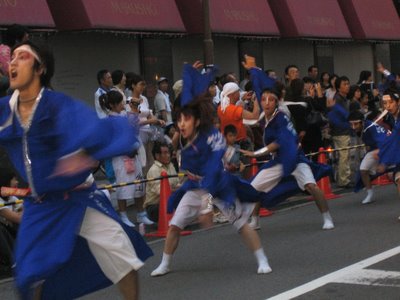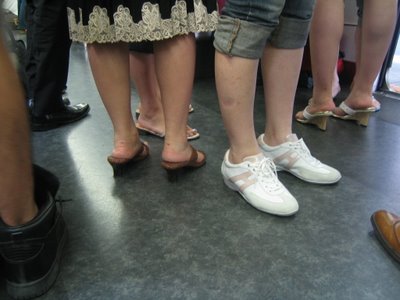
Japan is a world on its own. Nature, temples, festivals, skyscrapers, bullet train. Everything co-exist in harmony in the same space. There are so many realities here. From the Buddhist monk and pilgrims, to the Shibuya girls and gothic Harajuko.
A matsuri is a traditional festival. To tourists, witnessing a matsuri may be the high point of their trip to Japan. To locals it means a festival to celebrate something, or even a point to gather. To me, it is part of my living experience as a guest of this country. Bright colours, loud chanting, beating drums and myriads (do you remember my
series of pictures with that name? it was in
Gion Matsuri in Kyoto).
True shinto matsuri can be traced back to the sacred rites of Japan's rice farming people in Yayoi (from 300BC) and pre Yayoi periods. These rites were performed to ensure a good rice harvest, to propitiate the gods and to pray for the health of the community. Although matsuri have evolved, their central meanings still reflect their agrarian roots.
In Heian period (794-1185), Japan adopted a range of Buddhist and secular rites from China, adding them to native Shinto matsuri. Matsuris vary in content and form, but Shinto matsuris have common elements. The first element of a Shinto matsuri is a period ranging from several days to a week in which the shrine priests ritually purify themselves in order to enter into communication with the kami (god) of the shrine. This is usually followed by an offering to the kami. Typical offerings include rice, mochi (pounded rice cakes made of glutinous rice), sake or fruit and vegetables. Following this, there is a ritual communication with the kami in which matsuri participants partake of these offerings. Much of this rituals happen behind closed doors. The most visible feature of any matsuri is a procession of mikoshi (or portable shrines) in which the kami is paraded around the neighbourhood on the backs of chanting young men (and, occasionally women). This is what I've been witnessing myself since I came to this country.
In some matsuri, the portable shrine may be carried down a mountainside, an act symbolic of bringing the Mountain God down to the rice fields to watch over the harvest. After the harvest is completed, another matsuri is performed in which the kami is returned to its mountaintop abode.
There are thousands of matsuri celebrated each year in Japan. Kyoto, Nara and Tokyo are especially famous for their festivals, but you can find matsuris in every corner of Japan. The most traditional festival in Wakayama Prefecture (where I live) takes place in Kumano [1] and it is the Nachi-no-Hi matsuri (Nachi fire festival) on July 14th [2].
Two weeks ago the Bundara Odori (summer dance festival) took place in my city. I was supposed to perform traditional dances with other foreign students but I got heat exhaustion the day before and decided to withdraw. Another dance festival was held this weekend. While the first festival was more traditional in music and dances, the second one was outstanding in colours and dances. I took active part of the Bundara Odori last year, and I will do so as long as my health and university commitments allow me to. Nonetheless, I enjoyed this weekend matsuri much more than the traditional one. It is more modern, the dances where more frenetic. The members of the groups danced with all their beings. It was amazing! Each performing group was preceded by a truck, especially decorated for the occasion, playing the music of the group, and a leader whose purpose was to encourage the members through powerful chorus to the songs and encouragement sentences.
[1] In Heian period, Kumano-san-zan (Mount Kumano) became worshipped as Nr. 1 miraculous place in Japan. Pilgrimage to this place became the ardent wish of the people aspiring the profit of this world and paradise after death. There are five pilgrimage routes to this shrine. Walking on foot was regarded as a principle of the mountain training to acquire the power of the nature and the universe, and people were comforted and contented through an extraordinary experience.
[2] Nachi-no-Hi matsuri is one of the three largest fire festivals of Japan. It takes place in Kumano mountains in Wakayama Prefecture, an area included in the
UNESCO World Heritage list. Twelve vermilion mikoshi (portable shrines), six metres tall, decorated with ogi fans and mirrors are designed in the image of the Nachi-no-Otaki (the Great Waterfall of Nachi) near the shrine. At the Kumano Nachi Taisha Shrine, the waterfall itself is the object of worship and is regarded as a deity. During the festival, you can enjoy viewing the mystical scene of twelve huge 50-kgs. Pine torches waved around so very close to these portable shrines that sometimes looks like if the portable shrines are about to be scorched. The enormous pine torches represent the twelve deities dwelling in Kumano as well as the twelve months of the year. The portable shrines, which are shaped with the image of the sacred falls, are filled with the spirits of the twelve gods, and then purified by the fire of the pine torches. In this way, vitality is enhanced through these sacred rituals, aim of this festival.
Acknowledgement: This article was written based on the Lonely Planet Japan article about festivals in Japan, the
Wakayama Tourism Federation and the
Japan National Tourism Organization (JNTO).





